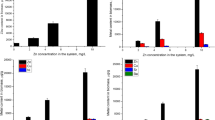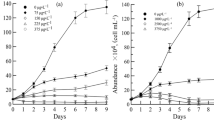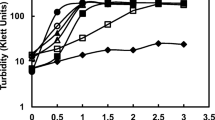Abstract
The effects of copper and zinc on Spirulina platensis (Nordst.) Geitl. growth and the capability of this cyanobacterium for accumulation of these heavy metals (HMs) were studied. S. platensis tolerance to HMs was shown to depend on the culture growth phase. When copper was added during the lag phase, its lethal concentration was 5 mg/l, whereas 4 mg/l were lethal during the linear growth phase. Zinc concentration of 8.8 mg/l was lethal during the linear but not lag phase of growth. HM-treated S. platensis cells were capable for accumulation of tenfold more copper and zinc than control cells. Independently of Cu2+ content in the medium and of the growth phase, cell cultures accumulated the highest amount of this metal as soon as after 1 h, which may be partially determined by its primary sorption by cell-wall polysaccharides. A subsequent substantial decrease in the intracellular copper content occurred due to it secretion, which was evident from the increased metal concentration in the culturing medium. When zinc was added during the linear growth phase, similar pattern of its accumulation was observed: the highest content after 1 h and its subsequent decrease to the initial level. When the initial density of the culture was low and the cells had much time to adapt to HM, zinc accumulated during the entire linear growth phase, and thereafter the metal was secreted to the medium. The mechanisms of S. platensis tolerance to HM related to both their sorption by the cell walls and secretion of metal excess into the culturing medium and its conversion into the form inaccessible for the cells are discussed.
Similar content being viewed by others
Abbreviations
- HM:
-
heavy metal
REFERENCES
Sandau, P., Sandau, E., and Pulz, O., Heavy Metal Sorption by Microalgae, Acta Biotechnol., 1996, vol. 16, pp. 227–235.
Bekasova, O.D., Orleanskii, V.K., and Nikandrov, V.V., Formation of Cadmium Sulfide and Metallic Cadmium Crystallites on the Surface of Cyanobacterium Nostoc muscorum, Fiziol. Rast. (Moscow), 2000, vol. 47, pp. 263–271 (Russ. J. Plant Physiol., Engl. Transl.).
Lloyd, J.R., Microbial Reduction of Metals and Radionuclides, FEMS Microbiol. Rev., 2003, vol. 27, pp. 411–425.
Tomsett, A.B. and Thurman, D.A., Molecular Biology of Metal Tolerances of Plants, Plant Cell Environ., 1988, vol. 11, pp. 383–394.
Sentsova, O.Yu. and Maksimov, V.N., Effects of Heavy Metals on Microorganisms, Usp. Mikrobiol., 1985, vol. 20, pp. 227–252.
Cobbett, C. and Goldsbrough, P., Phytochelatins and Metallothioneins: Roles in Heavy Metal Detoxification and Homeostasis, Annu. Rev. Plant Physiol. Plant Mol. Biol., 2002, vol. 53, pp. 159–182.
Bityutskii, N.P., Mikroelementy i rastenie (Micronutrients and Plant), St. Petersburg: S.-Pb. Gos. Univ., 1999.
Udel’nova, T.M. and Yagodin, B.A., Zinc in the Life of Plant, Animal, and Human, Usp. Sovrem. Biol., 1993, vol. 113, pp. 176–189.
Prasad, A.S., Zinc: An Overview, Nutrition, 1995, vol. 11, pp. 93–99.
Failla, M.L., Zinc Function and Transport in Microorganisms, Microorg. Minerals, 1977, pp. 151–214.
Cavet, J.S., Borrelly, G.P.M., and Robinson, N.J., Zn, Cu and Co in Cyanobacteria: Selective Control of Metal Availability, FEMS Microbiol. Rev., 2003, vol. 27, pp. 165–181.
Blencowe, D.K. and Morby, A.P., Zn(II) Metabolism in Prokaryotes, FEMS Microbiol. Rev., 2003, vol. 27, pp. 291–311.
Laube, V.M., McKenzie, C.N., and Kushner, D.J., Strategies of Response to Copper, Cadmium, and Lead by a Blue-Green and a Green Alga, Can. J. Microbiol., 1980, vol. 26, pp. 1300–1311.
Upitis, V.V., Makro-i mikroelementy v optimizatsii mineral’nogo pitaniya mikrovodoroslei (Macro-and Micro-nutrients in Optimization of Mineral Nutrition of Microalgae), Riga: Zinatne, 1983.
Katalog kul’tur mikrovodoroslei v kollektsiyakh SSSR (Catalogue of Microalgal Cultures in the Collection of USSR) Semenenko, V.E., Ed., Moscow: IFR RAN, 1991.
Pronina, N.A., Kovshova, Yu.I., Popova, V.V., Lapin, A.B., Alekseeva, S.G., Baum, R.F., Mishina, I.M., and Tsoglin, L.N., The Effect of Selenite Ions on Growth and Selenium Accumulation in Spirulina platensis, Fiziol. Rast. (Moscow), 2002, vol. 49, pp. 264–271 (Russ. J. Plant Physiol., Engl. Transl.).
Golubkina, N.A., Selenium Determination by Fluorimetry, Zh. Anal. Khim., 1995, vol. 50, pp. 492–497.
Akira, N., Takao, H., and Takashi, S., Uptake of Copper Ion by Green Microalgae, Agr. Biol. Chem., 1979, vol. 43, pp. 1455–1460.
Bubela, B. and Powel, T., Effects of Copper on the Composition of Bacterial Cell Wall Peptides, Zentr.-Bl. Bacteriol., 1973, vol. 128, pp. 457–466.
Fisher, N.F. and Jones, G.J., Heavy Metals and Marine Phytoplankton — Toxicity and Sulfhydryl Binding, J. Phycol., 1982, vol. 17, pp. 108–111.
Albergoni, V., Piccini, E., and Coppelotti, O., Response to Heavy Metals in Organisms, Compar. Biochem. Physiol., 1980, vol. 67, pp. 121–127.
Beveridge, T.J. and Murray, R.C.E., Sites of Metal Deposition in the Cell Wall of Bacillus subtilis, J. Bacteriol., 1980, vol. 141, pp. 876–877.
O’Halloran, T.V. and Cullota, V.C., Metallochaperones, an Intracellular Shuttle Service for Metal Ions, J. Biol. Chem., 2000, vol. 275, pp. 25 057–25 060.
Cobine, P., Wickramasinghe, W.A., Harrison, M.D., Weber, T., Soloiz, M., and Dameron, C.T., The Enterococcus hirae Copper Chaperone CopZ Delivers Copper(I) to the CopY Repressor, FEBS Lett., 1999, vol. 445, pp. 27–30.
Poulos, T.L., Helping Copper Find a Home, Nat. Struct. Biol., 1999, vol. 6, pp. 709–711.
Author information
Authors and Affiliations
Additional information
Translated from Fiziologiya Rastenii, Vol. 52, No. 2, 2005, pp. 259–265.
Original Russian Text Copyright © 2005 by Nalimova, Popova, Tsoglin, Pronina.
Rights and permissions
About this article
Cite this article
Nalimova, A.A., Popova, V.V., Tsoglin, L.N. et al. The effects of copper and zinc on Spirulina platensis growth and heavy metal accumulation in its cells. Russ J Plant Physiol 52, 229–234 (2005). https://doi.org/10.1007/s11183-005-0035-4
Received:
Issue Date:
DOI: https://doi.org/10.1007/s11183-005-0035-4




